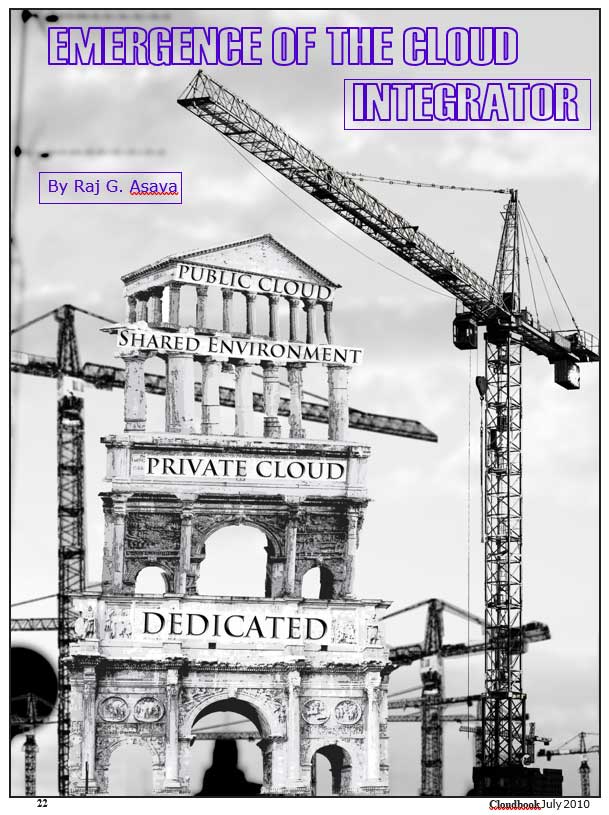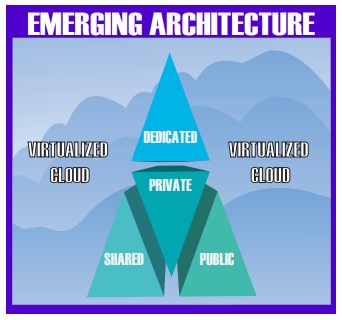Emergence of the Cloud Integrator
By Raj G. Asava, founder and CEO of Asava Consulting, Inc
Summary: As the IT Outsourcing industry goes through another transformation driven by Cloud Computing, businesses will need a trusted Cloud Integrator to help them configure the right computing environment, addressing their unique business needs.

Four-Tier Architecture and Smart Integration Allow companies to take advantage of the benefits offered by the different types of Clouds.
While some claim Cloud Computing is the next disruptive technology, others suggest it is the harbinger of the diminishing role of the Systems Integrator. A closer examination reveals that it is neither. But whatever descriptor is finalized for Cloud Computing, harvesting its benefits will require the guidance and direction of an emerging breed of systems integrator - Cloud Integrator
Cloud Computing DE-Mystified:
There are many definitions for Cloud Computing from credible sources:
- Gartner defines Cloud Computing as a style of computing in which massively scalable IT-related capabilities are provided "as a service" using Internet technologies to multiple external customers.
- Forrester defines Cloud Computing as a pool of abstracted, highly scalable, and managed compute infrastructure capable of hosting end-customer applications and billed by consumption.
Cloud Computing is a highly automated, readily scalable, on-demand computing platform of virtually un-limited processing, storage and ubiquitous connectivity, always available to carry out a task of any size and charged based upon usage. It is certainly poised to be as pervasive a platform as the internet, in the very near future.
The Evolution Of Cloud Computing:
Advancements in technology, coupled with declining costs, have disrupted traditional business models, and a new category of companies has emerged: One that operates mostly over the internet based on "clicks" (e.g. Amazon, e bay, and Google). The established businesses suddenly found that the development of this channel was critical for their survival against the new breed of companies, and they started to offer a combination of "bricks and clicks" for the convenience of their customers.
The disruption of business models created a higher demand and dependence on it. Also contributing to this dependence are "peaks and valleys" of IT capacity needs, tied directly to the nature of an organization's business activity (seasonal, one-time, quarter/year-end, day/night, etc.). To ensure consistent, stable operations and to virtually eliminate risks, businesses built their computing platforms at or above the highest peak points of their IT requirements. As a result, many businesses today are stuck with bloated computing platforms that are enormously underutilized for the majority of the time, taking up real estate, depreciating fast in value, and consuming significant amounts of energy and resources.
In response to this operational predicament, companies such as Amazon invested heavily in building massively scalable computing platforms, while commoditizing their own idle capacity, and monetizing it under their EC2 and S3 labels. Ec2, elastic compute cloud, is a web-based service that allows any entity to buy and use compute capacity on an as-needed basis. The S3, simple storage services provides for web-based storage and access to data. The fact that both of these services operate out of a standard browser, and do not require any proprietary/licensed software, make them extremely usable.
The morphing role of systems integrator into cloud integrator
The primary focus of an integrator continues to be planning, optimizing, integrating, and managing clients' heterogeneous compute environments. However, at times, they take on the responsibility of filling the gaps between the clients' IT needs and the available compute infrastructure.
The emerging cloud computing companies are proving to be yet another Partner in a typical integrator business model. The availability of a public domain computing platform (a.k.a. Cloud computing) allows the integrator to extend their compute platform as needed, through lease type agreements as opposed to capital outlay or long term fixed costs. While organizations may be lured to the affordability and scalability that Cloud Computing offers, it is a seasoned Cloud Integrator that ensures the environment is architected such that it provides these advantages without compromising on security and interoperability.
THE EMERGING CONCEPTUAL ARCHITECTURE:
At the onset, the low cost and ready access to ondemand computing offered through a cloud environment will cause businesses to rethink what is truly core (mission-critical, highly sensitive/secretive), and shift an increasing amount of non-core processing to a shared or cloud environment. Organizations will be well-served to revisit the classification of each piece of processing and storage that was earlier assumed to be sensitive and mission critical.

As CIOs develop reference architectures of their functions, processes and data based on the strategy of their business, experienced Cloud Integrators will help them configure their IT environment based on the following fourtier architecture.
- Dedicated: This tier is for computing related to the true core competency of an organization. The dedicated layer suggests a highly secure computing environment, where mission-critical tasks are processed and highly sensitive information is stored. Leakage would give away the competitive advantage, or degradation of performance and reliability could prove catastrophic to the business.
- Private Cloud: This tier addresses similar needs as the "Dedicated" layer and is used for developing, enhancing and testing mission-critical systems as well as carrying out critical research and development work. As such, it needs an environment that is highly secure like the dedicated layer. Built on the principles of virtualization, this layer will be designed to be readily scalable and sharable between IT systems and applications within the organization.
- Shared Environment: A shared environment represents the tier that addresses the predictable compute need required to run regularly scheduled applications such as facilities management, accounting, and payroll processing. As such, this tier is carried out at an outsourcer's facility, where the computing platform may be dedicated for the business, but the ancillary processes and resources are leveraged across multiple clients.
- Public Cloud: Public cloud tier represents the various types of external clouds (like the EC2 and S3) available to an organization. A Cloud Integrator would configure them such that it operates as an extension to the computing platform of an organization ready to handle the spikes in its computing needs.
Due to the open nature of the public cloud, an organization must be able to disaggregate its system and parse out its computing needs into transactions that can be carried out in the external cloud without fear of exposing or losing its critical information.
In today's cost-sensitive environment, Cloud Computing certainly holds the promise of reducing a company's total cost of IT ownership. For organizations to be successful, they are best served to visualize and architect their compute environment based on this four-tier structure.
Cloud Computing: How Real Is IT?
Skeptics who believe Cloud Computing to be just another buzzword or the "flavor of the month" should remember that just a decade ago, the concept of offshoring IT work also faced strong headwinds on political, business and social fronts. In a global economy, the benefits of off-shoring -- in the form of reduced cost, high availability of quality resources, and faster response time due to around-the-clock operations -- caused most, if not all, businesses to cut over to some derivation of an offshore-based model.
As the IT Outsourcing industry goes through another transformation driven by Cloud Computing, businesses will depend upon the services of a skilled and trusted Cloud Integrator as a partner to help them configure the right combination of computing environment that addresses their unique business needs, in the most cost effective manner without compromising on performance and security

